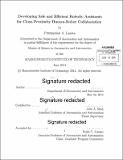Developing safe and efficient robotic assistants for close-proximity human-robot collaboration
Author(s)
Lasota, Przemyslaw A. (Przemyslaw Andrzej)
DownloadFull printable version (6.962Mb)
Other Contributors
Massachusetts Institute of Technology. Department of Aeronautics and Astronautics.
Advisor
Julie A. Shah.
Terms of use
Metadata
Show full item recordAbstract
As the field of robotics continues to advance and the capabilities of robots continue to expand, there is a strong incentive to introduce robots into traditionally human-only domains. By harnessing the complementary strengths of humans and robots, the human-robot team has the potential to achieve more together than neither could alone. To allow for the paradigm shift from isolation to collaboration, however, technologies in support of close-proximity human-robot interaction must be developed. The first contribution of this thesis is the development and evaluation of a real-time safety system designed specifically for close-proximity human-robot interaction. The developed safety system, which uses a continuously updated virtual representation of the workspace for accurate human-robot separation distance calculation, is shown to allow for safe human-robot collaboration at very small distances of separation and with a very low latency. Furthermore, it is shown that this soft real-time system does not require hardware modification, which makes it easy and inexpensive to deploy on current industrial robots. To understand how humans respond to adaptive robotic assistants, and whether the response leads to efficient and satisfying interaction, a robot control architecture capable of Human-Aware Motion Planning, a type of motion-level adaptation, is implemented. This architecture is then used in a human-subject experiment in which participants perform a collaborative task with the robot in two distinct motion planning modes: human-aware and standard. The fluency of the team in both modes is then compared with the use of quantitative metrics like task execution time, amount of concurrent motion, human idle time, robot idle time, and human-robot separation distance, as well as a subjective evaluation of the robot based on questionnaire responses. It is shown that Human-Aware Motion Planning leads to improvements across all quantitative metrics and to a more satisfied human co-worker.
Description
Thesis: S.M., Massachusetts Institute of Technology, Department of Aeronautics and Astronautics, 2014. Cataloged from PDF version of thesis. Includes bibliographical references (pages 79-81).
Date issued
2014Department
Massachusetts Institute of Technology. Department of Aeronautics and AstronauticsPublisher
Massachusetts Institute of Technology
Keywords
Aeronautics and Astronautics.